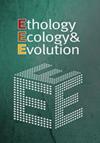个体大小与雌性攻击性和生理的相关性表明,独立形成的社会性纸蜂(Mischocyttarus pallidipectus,膜翅目蜂科)在成虫前对种姓有影响
IF 1.3
4区 生物学
Q4 BEHAVIORAL SCIENCES
引用次数: 1
摘要
生殖等级是真群居昆虫的一个决定性特征。生殖种姓分化的发育时机对塑造个体生殖灵活性的机会很重要。由于昆虫的硬体尺寸(如翅膀长度)在成虫羽化时是固定的,因此形态学可以用来评估成虫前对种姓地位的影响。在种姓单一性物种中,成年群体配偶之间的体型差异可能会影响对资源的社会竞争和生殖地位。我们的目标是利用体型与雌性行为和生理的相关性来检验三种假说中出现前对白斑纸黄蜂群体中雌性种姓的影响:(1)卵巢发育和未发育的雌性之间没有大小重叠,表明种姓可能是在幼虫发育期间决定的;(2)生殖个体的尺寸偏差(例外):在发育过程中可能存在种姓偏差,但可能存在后出现因素;(3)没有大小模式:没有成年前种姓偏见的形态学证据。在蜂群中,我们发现卵巢发达与未发育的雌性在体型(翼长)上存在显著差异:较大的雌性更有可能发育卵巢。此外,体型较大的雌性对配偶更具攻击性。然而,体型对卵巢发育和行为优势的影响存在相当大的差异:甚至一些体型最小的雌性也发育了卵巢,并且具有社交攻击性。这些数据表明,在成年前发育过程中的因素导致形态(大小)差异,并且身体大小影响成年相互作用的结果与生殖种姓的含义。本文章由计算机程序翻译,如有差异,请以英文原文为准。
Body size correlations with female aggression and physiology suggest pre-adult effects on caste in an independent-founding eusocial paper wasp (Mischocyttarus pallidipectus, Hymenoptera Vespidae)
Reproductive castes are a defining characteristic of eusocial insects. The developmental timing of reproductive caste differentiation is important to shaping individual opportunities for reproductive flexibility. Because hard-part body size (e.g., wing length) is fixed for insects upon adult emergence, morphology can be used to assess pre-adult effects on caste status. Differences in body size amongst adult colony mates may affect social competition for resources and reproductive status in caste-monomorphic species. Our goal was to use body size correlations with female behavior and physiology to test among three hypotheses for pre-emergent effects on female caste within colonies of Mischocyttarus pallidipectus paper wasps: (1) no size overlap between females with developed and undeveloped ovaries would indicate caste is likely determined during larval development; (2) size bias for reproductives with exceptions: caste could be biased during development, but post-emergence factors may play a role; (3) no size patterns: no morphological evidence for pre-adult caste biases. Within colonies, we found a significant difference in body size (wing length) between females with developed vs undeveloped ovaries: larger females were more likely to have developed ovaries. Additionally, larger females were more aggressive towards nestmates. However, there was considerable variation in body size effects on both ovary development and behavioral dominance: even some of the smallest-bodied females had developed ovaries and were socially aggressive. These data suggest factors during pre-adult development lead to morphological (size) differences, and that body size affects the outcome of adult interactions with implications for reproductive caste.
求助全文
通过发布文献求助,成功后即可免费获取论文全文。
去求助
来源期刊

Ethology Ecology & Evolution
生物-动物学
CiteScore
3.10
自引率
0.00%
发文量
44
审稿时长
>12 weeks
期刊介绍:
Ethology Ecology & Evolution is an international peer reviewed journal which publishes original research and review articles on all aspects of animal behaviour, ecology and evolution. Articles should emphasise the significance of the research for understanding the function, ecology, evolution or genetics of behaviour. Contributions are also sought on aspects of ethology, ecology, evolution and genetics relevant to conservation.
Research articles may be in the form of full length papers or short research reports. The Editor encourages the submission of short papers containing critical discussion of current issues in all the above areas. Monograph-length manuscripts on topics of major interest, as well as descriptions of new methods are welcome. A Forum, Letters to Editor and Book Reviews are also included. Special Issues are also occasionally published.
 求助内容:
求助内容: 应助结果提醒方式:
应助结果提醒方式:


